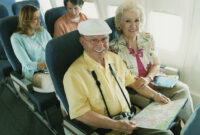Tours for seniors traveling alone represent a burgeoning sector of the travel industry, catering to a demographic with unique needs and desires. This guide explores the diverse options available, from escorted tours offering comprehensive support to independent travel packages allowing for greater personal freedom. We delve into crucial safety and security considerations, accessibility requirements, and budget planning strategies, ensuring a fulfilling and worry-free solo adventure for senior travelers. We also address the social aspects of solo travel, offering advice on combating loneliness and fostering meaningful connections along the way.
The information presented here aims to empower seniors to confidently plan and enjoy their solo journeys, providing practical advice and resources to navigate the various aspects of independent travel. From choosing the right tour type and destination to managing potential challenges and maximizing enjoyment, this guide serves as a valuable companion for anyone embarking on a solo adventure.
Accessibility and Accommodation Needs
Planning a tour for senior travelers requires careful consideration of accessibility and accommodation needs. Many seniors may have mobility limitations, sensory impairments, or require specific medical assistance, impacting their ability to fully enjoy the travel experience. Understanding these needs and providing appropriate solutions is crucial for ensuring a safe and enjoyable trip.
Common Accessibility Challenges and Solutions for Senior Travelers
Addressing accessibility challenges proactively ensures a positive travel experience for senior solo travelers. The following table outlines common challenges, practical solutions, illustrative examples, and important considerations for tour operators.
| Challenge | Solution | Example | Tour Operator Considerations |
|---|---|---|---|
| Limited Mobility | Provide accessible transportation (e.g., wheelchair-accessible buses, vans), choose hotels with elevators and ramps, plan itineraries with minimal walking. | A tour featuring a scenic train journey instead of extensive walking tours. | Pre-trip questionnaires assessing mobility levels, collaboration with accessible transportation providers. |
| Hearing Impairment | Provide written materials, use visual aids during tours, ensure guides are aware and can communicate effectively. | Guided tours with captioned videos or written summaries of key information. | Training guides on communication techniques for hearing-impaired individuals, providing written itineraries and tour descriptions. |
| Visual Impairment | Provide detailed verbal descriptions, use tactile materials, and consider alternative activities catering to visual limitations. | Audio descriptions of landmarks and museums, hands-on activities like pottery or wine tasting. | Partnering with organizations specializing in accessible travel for the visually impaired, providing detailed audio guides. |
| Medical Needs | Ensure access to medical facilities, provide emergency contact information, and accommodate medication schedules. | Tours with nearby hospitals or clinics, itineraries allowing for rest periods and medication administration. | Collaborating with local medical providers, providing clear emergency procedures, and offering flexible itinerary options. |
Finding Senior-Friendly Accommodations
Locating suitable accommodations is crucial. Senior travelers often benefit from hotels and other lodging options that offer accessible rooms and readily available medical assistance. Websites specializing in accessible travel often provide detailed listings and reviews, filtering options by specific needs such as wheelchair accessibility, grab bars in bathrooms, and proximity to medical services. Directly contacting hotels to discuss specific needs and request confirmation of accessibility features is also recommended. Many hotels now offer packages tailored to senior travelers, including assistance with luggage and in-room amenities.
Considering Personal Mobility Limitations When Choosing a Tour
Before booking, thoroughly review the tour itinerary, paying close attention to the level of physical activity involved. Look for tours that offer options for different fitness levels, allowing seniors to choose activities that match their capabilities. Descriptions should clearly state the amount of walking, stair climbing, or other strenuous activities involved. Choosing tours with slower paces, fewer strenuous activities, and more rest stops is essential for ensuring a comfortable and enjoyable trip for senior travelers with mobility limitations.
Wrap-Up
Embarking on a solo journey as a senior can be a richly rewarding experience, offering opportunities for self-discovery, personal growth, and the creation of lasting memories. By carefully considering the factors outlined in this guide – from safety and security to budgeting and social interaction – seniors can plan and execute a travel experience that is both fulfilling and enjoyable. Remember that thorough preparation, a positive attitude, and a willingness to embrace the unexpected are key ingredients for a successful solo adventure. Safe travels!




